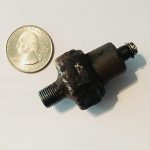or not…

Every item on my shelf of items has a story. This is an oil pressure transducer. Its design goal is to alert the operator, via red light and aural warning when there is no pressure. It is a 7 psi switch that taps into an engine’s oil gallery. Its default is closed meaning that when oil pressure is non existent it allows 12 volt current to complete a circuit and provide warning. If there is pressure the switch is open and therefore, no circuit. Everything is quiet and the machine in operation is assumed to be a-okay.
Tracing a route down the Savannah River on my way out to sea, I heard a chirping noise that turned out to be the alarm system just described. It wasn’t a full on signal just an indication that it was on the cusp of something. Imagine my concern. I reduced the throttle on my auxiliary diesel and the alarm came full on. Adding power and the alarm grew silent. It was unnerving, without an actual pressure gauge for verification, I couldn’t know whether, the engine was on its last legs or indication system anomaly.
I decided to error on the side of caution and discontinued engine usage, relying on the wind and sailpower to delivery me home. If the engine was to die it would perform a final task of delivering me the remaining few yards and into the waiting marina berth at end of journey.
The diesel ran fine when restarted for arrival and when shutdown safely back at home port. Further, the antagonizing low pressure warning from before never recurred. Phew! I had been under pressure. Now I need to confirm if in fact the transducer switch had perished or was it trying to tell the truth.
There are just a few causes of low oil pressure:
- Oil level extremely low
- Oil viscosity very weak due to contamination and thinning
- Engine wear tolerances usually bearings or oil pump
The oil quantity was easily ruled out as I use the dipstick check as a matter of pre-flight. The quality of the oil itself was a bit harder. There wasn’t any coolant mixed in so that was quickly discounted. I couldn’t be sure that diesel fuel wasn’t leaking into the crankcase. A laboratory oil analysis would be handy because all I could witness was slimy black ooze squeezed between fingers. That leaves the third bullet – this engine – which definitely qualifies. It has been in use for over 30 years and while loving cared for, it has aged.
Process of elimination: I pulled the oil filter and poured its contents into a plastic cup. I could have sent it off to a lab but I presented it to an experienced type in the boatyard facility for a free opinion. The pronouncement was plain ol’ used diesel crankcase oil. No unusual appearance or telltale odor.
That leaves the ultimate showdown — engine vs indication. I sourced a generic pressure gauge that when fitted to the port where the [removed] transducer switch had lived, would solve the question once-and-for-all.
The TEST: Ran engine through various speed regimes. Starting cold and also running under load at normal operating temperature.
Initial observation is that the pressure transducer switch is suspect. All of the readings were well above the 7 PSI threshold of the switch. It will be replaced. The only troubling aspect were some of the erratic recordings. This may be because of the simple gauge utilized. I did see some spikes that couldn’t be accounted for. In any event, 45 psi seems to be the average norm and an acceptable result.
Not completely convinced. Follows is a diagram of the internal pressure regulating valve. Has the appearances of a complex engineering diagram but in reality it’s just a spherical ball held against a relief orifice by a simple spring.

This is such a basic design and would be a rare point of failure. It either works or it doesn’t but might be explanation for the slight variances or fluctuations. A quality gauge would have dampening built in as a feature to eliminate erratic needle movement.
The engine manual lists standard pressure range as 35.56 ~ 49.78 as spec. I feel more confident after this test but it’s still on watch. I will continue to monitor (under pressure) until full trust is restored.
